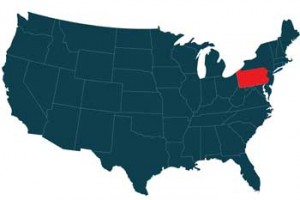Pennsylvania Emergency Vehicle Light State Statutes
 The state of Pennsylvania requires emergency vehicles to use warning lights whenever they are on public roadways. The type and color of lights that can be used depends on the type of emergency vehicle you drive. Below is a general overview of what kind of emergency vehicle lights are acceptable, along with a link to the associated ordinance for easy reference.
The state of Pennsylvania requires emergency vehicles to use warning lights whenever they are on public roadways. The type and color of lights that can be used depends on the type of emergency vehicle you drive. Below is a general overview of what kind of emergency vehicle lights are acceptable, along with a link to the associated ordinance for easy reference.
What is an "Emergency Vehicle?"
Under Pennsylvania State Code §121.1, an emergency vehicle is defined as "any vehicle that is designed to provide emergency or special services." This includes police and fire department vehicles, ambulances, military vehicles, any vehicle designed to transport blood or hazardous materials or any vehicle that's driven by the state medical examiner or Coroner.
Police Vehicles
You can find regulations for police vehicle lighting systems under Pennsylvania statute §173.3. Police vehicles typically use red and blue lighting, but they can also use white, clear, yellow or amber lights. The lights can rotate, flash or oscillate. Police lighting systems can be mounted on top of a cab or on the roof of the vehicle, and the lighting system cannot be mounted more than 18 inches from the highest point on the vehicle. The following types of mounting devices may be used:
- Mounts with a magnetic base
- Self-leveling gimbal mounts
- Roof rack mounts for light bars
- Grommet mount (for flush-mounted flashing light systems only)
Furthermore, all rotating, flashing or oscillating lights must meet or exceed chromacity coordinate, Standard Color metric System J578D, or the Color Specification for Signal Lighting September 1978 or subsequent SAE standards. Refer to the statute text linked at the beginning of this section for more information.
Fire Trucks
Lighting systems for fire trucks are covered in Statute 173.3(e)(1). The only colors permitted for use on fire trucks are as follows:
- Red
- Blue
- Clear
- Amber
- White
- Yellow
Fire truck lighting systems need to meet the same standards as with police vehicles. Private vehicles used as fire vehicles must mount their lighting systems as described under 75 Pa.C.S. §4571(a). If two or more lights are used, they must each be of the same color. Fire trucks are not allowed to use different-colored lighting in Pennsylvania. For more information, refer to Pennsylvania statute §173(a)(5)(ii). Volunteer firefighters are also covered under these laws.
Ambulances
 Pennsylvania statute §173.2 defines light standards for ambulances. Under this statute, ambulances must have at least one revolving or flashing strobe lights that are red, white or clear in color and at least two revolving or flashing lights that are blue, white or clear in color. Ambulances may also use light bars with these colors, but the light bar that's chosen cannot have more than two emergency lights.
Pennsylvania statute §173.2 defines light standards for ambulances. Under this statute, ambulances must have at least one revolving or flashing strobe lights that are red, white or clear in color and at least two revolving or flashing lights that are blue, white or clear in color. Ambulances may also use light bars with these colors, but the light bar that's chosen cannot have more than two emergency lights.
§173.4 requires that all wiring used in the lighting system is SAE-rated and of a large enough gauge to be able to handle the electrical load put out by the system. The ground wiring must also be of equal gauge.
Furthermore,all ambulances need to use an activation indicator. The indicator must activate automatically whenever the vehicle's lighting system is engaged. Those who violate this law can be penalized under §173.6. Penalties may include sanctions imposed according to 75 Pa.C.S. §6502(b).
Construction Trucks
Construction truck lighting is covered under §173(a)(5)(ii),same as fire trucks. Unlike fire trucks, however, construction vehicles must use amber or yellow lighting, and any light bars installed will need to be amber or yellow in color. Furthermore, like ambulances, construction vehicles will need a light activation indicator that automatically turns on when the lighting system is engaged.
For more information about what lights may be available to you, we suggest calling your State Highway Patrol office at: 717-783-5599
*Please note that these numbers are what we are currently able to find and the numbers may have changed since this listing.
Disclaimer: The emergency vehicle light state statute guide was created by Extreme Tactical Dynamics as a guide and reference. We make no claim to the accuracy or validity of this guide. This guide was written to the best of our knowledge and has been provided to our customers as a courtesy ONLY! The information in this guide is our interpretation of the law as we have read it. We cannot be held responsible for any errors as this is only our interpretation of the law and the laws are constantly changing. We cannot be held liable or responsible for any errors and recommend that our customers refer to their local authorities to confirm the particular statue that governs their use of emergency vehicle lights.
 Facebook
Twitter
Google+
Instagram
YouTube
Facebook
Twitter
Google+
Instagram
YouTube


